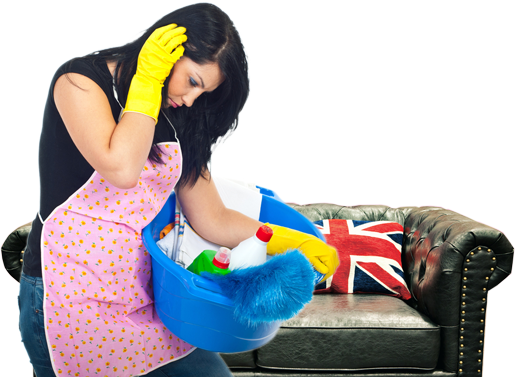Should You Consider Steam Cleaning Your Leather Sofa
Posted on 18/05/2025
Should You Consider Steam Cleaning Your Leather Sofa?
If you're a proud owner of a leather sofa, you know it's a statement piece that brings both comfort and elegance to your living room. Maintaining its lush texture and lustrous appearance requires proper care. Many homeowners often ask: Should you consider steam cleaning your leather sofa? In this comprehensive article, we'll explore the ins and outs of steam cleaning leather couches, discussing its benefits, risks, best practices, and alternative cleaning methods. By the end, you'll understand if steam cleaning is right for keeping your leather sofa pristine.

Understanding Leather and Its Cleaning Needs
Leather is a natural, breathable material derived from animal hides. Unlike synthetic fabrics, leather requires a special care routine to maintain its softness, prevent drying, and avoid surface cracking or fading. To preserve its luxurious feel, it's crucial to clean leather sofas correctly.
Common Types of Leather Used in Sofas
- Aniline leather - Very soft and natural, but is more susceptible to stains and fading due to its minimal surface protection.
- Semi-aniline leather - Slightly more durable, with a light protective coating offering moderate stain resistance.
- Protected/pigmented leather - Treated for increased robustness, often found in most modern leather sofas for its resistance against spills and scratches.
Each leather type demands a unique cleaning approach. Understanding your sofa's leather will help avoid costly mistakes when choosing the right cleaning technique, especially steam cleaning.
What Is Steam Cleaning?
Steam cleaning is a popular cleaning method that utilizes hot, pressurized steam to lift dirt, debris, and bacteria from surfaces without the need for chemicals. Traditionally, it's used for cleaning carpets, upholstery, and hard surfaces. The process involves a steam cleaner machine that heats water to produce steam, which is then directed onto the target area via a nozzle.
- Advantages: Kills bacteria, removes allergens, eco-friendly, chemical-free.
- Drawbacks: Can introduce moisture to surfaces that may be sensitive to water, like leather.
Can You Steam Clean a Leather Sofa?
This is the big question many homeowners face. Should you steam clean your leather couch? The answer is nuanced:
- Most manufacturers recommend against steam cleaning leather sofas directly. Steam can cause excessive moisture, leading to warping, fading, drying out, or even mold growth if not handled carefully.
- Steam cleaning may be possible for certain types of protected/pigmented leather, but extreme caution is required.
- Steam cleaning is never advised for unprotected leathers like aniline, nubuck, or suede.
Why Leather Can Be Sensitive to Steam
Unlike fabric upholstery, leather is a porous and absorbent material. High moisture and heat can strip oils from leather, leading to drying, stiffness, and permanent damage. Furthermore, if moisture penetrates the stitching or structure, there's a risk of internal mold or mildew growth.
Benefits of Steam Cleaning Your Leather Sofa (When Done Properly)
While steam cleaning leather sofas is generally risky, if performed with caution, it can offer some benefits for appropriate leather types:
- Sanitization: Steam kills germs, allergens, and dust mites without using harsh chemicals, making it ideal for homes with kids and pets.
- Gentle Stain Removal: Steam can help loosen some surface stains, making them easier to wipe away.
- Eco-Friendly: It's an environmentally responsible option with no chemical residue.
- Revitalizes Appearance: For some protected leathers, controlled steam can rejuvenate a tired, dull surface, restoring its shine and suppleness.
Potential Risks of Steam Cleaning Leather Sofas
It's easy to damage leather with improper steam cleaning. The most common risks include:
- Drying out the Leather: Steam can remove essential oils, causing the leather to become stiff and brittle.
- Staining and Discoloration: Excess heat or held-in moisture can leave patches or watermarks.
- Warping and Cracking: Prolonged exposure to steam may deform the leather or make it more prone to cracks.
- Damage to Glue and Internal Padding: Many sofas use adhesives or padding that may be sensitive to heat and moisture, leading to separation or mold.
- Increased Mold or Mildew Risk: If the leather or underlying materials don't dry thoroughly, harmful microbial growth can result.
How to Safely Steam Clean Your Leather Sofa (If You Must)
If you're determined to try steam cleaning your leather couch, follow these expert tips to minimize potential harm:
- Check the Manufacturer's Guidelines: Review your sofa's warranty and care instructions. If in doubt, contact the manufacturer. Proceed only if steam cleaning is explicitly approved.
- Test a Hidden Area: Always test on an inconspicuous spot, such as the back or underside, waiting 24 hours to check for adverse effects.
- Use a High-Quality Steam Cleaner: Opt for machines with adjustable temperature and moisture control. Use the lowest effective setting.
- Apply a Microfiber Cloth Attachment: Never direct steam straight at the leather. Instead, use a microfiber pad over the nozzle to disperse steam and absorb excess moisture.
- Keep the Nozzle Moving: Never let steam stay on one area for long; move continuously to avoid puddling and overheating.
- Minimize Exposure: Limit the steam application to a few seconds per area. Do not saturate the leather.
- Wipe Off Excess Moisture: Immediately follow up with a dry, soft cloth to absorb any dampness from the surface.
- Allow Proper Drying: Let your sofa dry naturally at room temperature - never use direct sunlight or a heater, which may dry out the leather excessively.
- Condition the Leather: Once dry, apply a suitable leather conditioner to replenish oils and preserve suppleness.
Warning: If your leather is unprotected or antique, steam cleaning is not recommended. For high-value pieces, always consult a leather restoration professional before attempting any intensive cleaning method.
Alternative Cleaning Methods for Leather Sofas
If steam cleaning isn't advisable for your leather sofa, don't worry! There are several effective and safe cleaning alternatives:
1. Regular Dusting and Vacuuming
- Use a soft, dry microfiber cloth to dust the surface weekly.
- Vacuum using a soft brush attachment to remove debris from crevices.
2. Gentle Wiping with Damp Cloth
- Dip a clean cloth in lukewarm distilled water and wring thoroughly. Wipe the leather gently to remove dirt, then dry with a second cloth.
3. Leather Cleaner Solutions
- Choose commercial leather cleaners approved by your sofa's manufacturer.
- Apply per instructions; do not oversaturate the leather.
4. Conditioning and Protecting
- Apply a high-quality leather conditioner every 6-12 months to restore oils and prevent drying.
Tip: Avoid using harsh household cleaners, ammonia, bleach, or abrasive pads on leather. These can cause irreversible damage.
When Should You Call a Professional?
For stubborn stains, deep cleaning, or valuable leather furniture, professional cleaning services are the safest option. Certified leather care experts have the right products, equipment, and experience to clean tough spots without risking damage. They can also assess whether controlled steam extraction might be beneficial for your specific sofa type.
Frequently Asked Questions About Steam Cleaning Leather Sofas
- Can steam cleaning kill allergens and bacteria on leather?
Yes, steam is effective at killing many pathogens, but you must use caution to avoid harming the leather surface. - Will steam cleaning help remove pet odors and stains?
Steam can help with mild odors and fresh stains, though ingrained smells may require professional deodorization. - Can I use a handheld garment steamer?
No. Household garment steamers are not designed for controlled cleaning on delicate surfaces like leather and can cause discoloration or damage. - What is the best cleaner for leather sofas?
Use specialized leather cleaning products following the manufacturer's instructions. Avoid regular soap, detergent, or alcohol.

Expert Tips for Extending the Life of Your Leather Sofa
- Keep Leather Away from Direct Sunlight: UV rays cause fading and drying over time.
- Avoid Heat Sources: Don't place your sofa near radiators or fireplaces.
- Clean Spills Immediately: Blot (don't rub) spills with a dry cloth as soon as they happen.
- Rotate Cushions: Even wear prevents sagging and extends lifespan.
- Apply Conditioner Regularly: Restores oils and keeps the leather supple.
Conclusion: Should You Steam Clean Your Leather Sofa?
The answer largely depends on the type of leather and the condition of your furniture. For most leather sofas, especially high-end or unprotected types, steam cleaning is a risky choice that can cause irreparable damage. However, for some well-sealed, protected leather sofas, careful, indirect steam cleaning may offer sanitizing benefits if used cautiously and infrequently.
If you choose to try steam cleaning your leather sofa, do so only after you've checked manufacturer guidance, tested an inconspicuous area, and taken all recommended safety steps. For the vast majority of cases, regular dusting, gentle wiping, and professional cleaning remain the safest ways to maintain your leather couch.
Ultimately, the best way to protect your investment is to prioritize proper maintenance and avoid harsh cleaning methods that threaten the natural beauty and durability of your leather sofa.
Have more questions about leather sofa care?
Browse our other articles or consult with a certified leather care specialist to keep your elegant leather furniture looking stunning for years to come.





